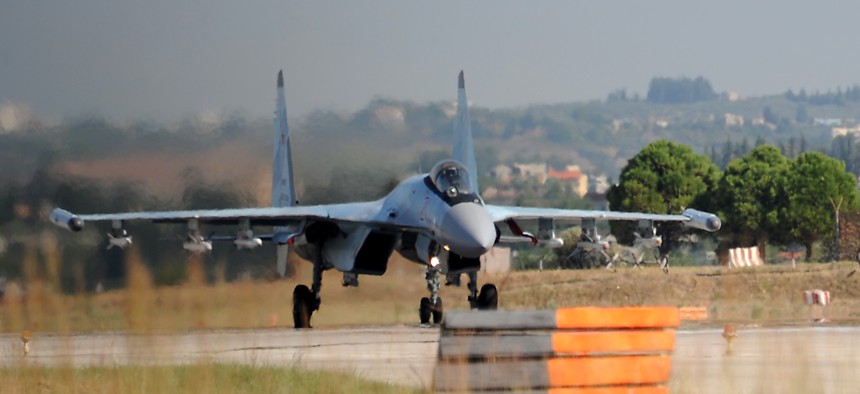MARCUS WEISGERBER
 Russian warplanes are flying increasingly close to American fighter jets in the skies over Syria “like they're trying to dogfight,” the top U.S. Air Force general in the region said.
Russian warplanes are flying increasingly close to American fighter jets in the skies over Syria “like they're trying to dogfight,” the top U.S. Air Force general in the region said.Since March 1, Russian pilots have acted in hostile ways that have U.S. military leaders concerned about the possibilities for miscalculation and escalation.
The Russians have been “increasingly bellicose in how they're approaching us,” Lt. Gen. Alexus Grynkewich, who leads Air Forces Central Command, said in an interview. “They're maneuvering aggressively against us when our protocols would say we're supposed to stay… several miles apart and just monitor each other.”
“[T]hey're aggressively maneuvering, almost like they're trying to dogfight, if you will,” Grynkewich said. “That's very concerning.”
Dogfighting is a term used to describe planes engaging each other in aerial combat.
The general’s message to his pilots: “Don't take the bait.”
“The guidance that I've given our folks is we're not going to act like they are,” Grynkewich said. “We're going to act in a professional manner, and we're going to try to de-escalate the situation.”
Since U.S. aircraft rarely fly alone, there are multiple aircraft to protect one another.
“We always try to keep one of our fighters in a position of advantage with respect to the Russians as they're trying to do the maneuvering against the other one,” Grynkewich said. The other [American] one basically, tries to de-escalate, to shake them, to get them to turn and go a different direction.”
The Wall Street Journal first reported increasingly hostile interactions between American and Russian warplanes, but not the dogfighting.
For years, American and Russian jets have shared the skies over Syria. U.S. aircraft have been fighting ISIS while Moscow’s planes have backed the Syrian government’s efforts to suppress anti-government rebels. U.S. and Russian military officials communicate regularly on a “deconfliction” telephone, sharing details about planned missions, including aircraft call signs and planes’ electronic transmission codes.
The two sides still have “some technical and professional exchanges” on the phone, Grynkewich said. “I think that that is good that the phones are still ringing, the phones are still being picked up. But the physical manifestation of their behavior is concerning nonetheless.”
And the general said U.S. officials’ complaints about the encounters with Moscow appear to fall on deaf ears. Russian forces will say these long-standing protocols “don't apply anymore in this particular area,” he said.
In mid-March, a Russian Sukhoi fighter jet collided with an American MQ-9 drone over the Black Sea. Russia’s defense minister awarded medals to the pilots, which Grynkewich said could encourage other Russian pilots to fly aggressively.
“Tactically, I think they're becoming less disciplined as an Air Force, and operationally, the things that their leadership is asking them to do or allowing them to do is really undermining my assessment of them as a professional Air Force,” he said.
Armed Russian warplanes have also flown over American ground troops in Syria.
“I don't think there's any intent on the Russians to fire on an American, but the risk of miscalculation or someone just making a mistake is way higher than it needs to be,” Grynkewich said.
No comments:
Post a Comment